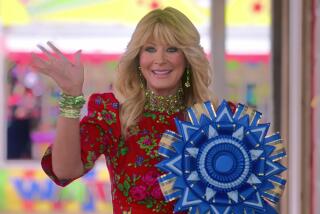Love her or hate her, Deborah Czeresko is the unlikely star of Netflix’s ‘Blown Away’
“Rude.” “Narcissistic.” “Feminist queen.” “The best part of that entire show.” As the Twittersphere has caught up with “Blown Away,” the Canadian reality-competition series that’s taken Netflix by storm, one thing is clear: Deborah Czeresko was right. In the first episode of the glassblowing showdown, the Tulane University-trained, New York City-based artist — a 30-year veteran of the craft — introduces herself as an acquired taste. “I think I’m a very polarizing personality,” she says to camera. “I have lovers and I have haters.”
Whether you consider her the villain or the heroine of “Blown Away,” Czeresko, who days ago turned 58, has emerged as the unlikeliest reality TV star since Wendy Pepper, the Middleburg, Va., mom who stirred up controversy in the debut season of “Project Runway.” With thick-rimmed specs, blunt bangs and a flair for provocative, political work, Czeresko cuts a striking figure in the 10-part competition — easily binge-able at 23 minutes an episode — and it’s not only because her projects, such as sprouted potatoes and larger-than-life breakfasts, are likely to elicit strong responses of their own. As an accomplished, unapologetic and, yes, demanding woman artist, Czeresko must confront sexist reality TV tropes in addition to art world misogyny.
“To me, it’s almost a political act,” she says in the series, “to occupy the hot shop as a fierce female glassblower.”
It’s also been a boon to glassblowing. Czeresko, who sits on the board of the New York nonprofit UrbanGlass, reports that people are already signing up for classes because of “Blown Away” — to the point that they need more classes for beginners. “This is the most exposure that glassblowing has probably ever gotten,” she says.
The Times caught up with Czeresko — fresh off fracturing her ankle in a surfing accident — by telephone to discuss the backlash she saw coming; the heartfelt notes she didn’t; and a “frightening,” “motivating” experience at a glass factory in Murano, Italy.
What made you to want ‘polarizing’ to be the first way you described yourself on camera?
Afterward, I was like, “Why did I do that? That was the stupidest thing I’ve ever done.” I just know my personality. I usually have that kind of thing happen to me, and I knew I wouldn’t be hiding myself. I knew that I’d try to be bringing my point of view from my history with glass to the table, having a global platform for it. I don’t know what prompted me to say it — but it did pan out.
Did you feel that you had that effect on your fellow contestants, or is that based on the reactions that you’ve seen since the show started airing?
The other contestants, we didn’t have that type of relationship, except for — sometimes we would get heated in the moment, like when I was making the foot [in the season’s ninth episode], when Janusz responded to my — raised voice, shall we say. What you don’t see on camera is what was really happening. My assistant was across the studio, and she couldn’t hear me... But I expected there to be a backlash to my claiming my space as a woman in the hot shop and my feminist approach to glass, and I knew that the moment you go up against the straight, white, cis culture, you’re going to get backlash for it, because that’s the status quo. So I expected there’d be lovers and haters, honestly. That’s been my life.
Had you watched much reality TV before being on ‘Blown Away’? Were you aware of some of the tropes around reality TV ‘villains,’ especially women?
I’ve seen reality TV. A lot of it I can’t even watch, it’s so bad. I tried to watch “Big Brother” yesterday, and I was like, “Ugh. Get me away from that.” ... A lot of it is hideous, superficial [bull]. I don’t know the stereotypes. I’ve watched “Project Runway.” “RuPaul’s Drag Race.” There’s, like, women crying all the time on “Project Runway” — no, “[Work of Art:] The Next Great Artist,” that was the one where there’s a lot of crying.
There are people on reality TV who, as a competitive strategy, try to position themselves as the ‘villain.’ The cliched way of saying it is, ‘I’m not here to make friends.’ But it sounds like your assessment was based on your experience in the art world, and the wider world.
My whole history of blowing glass, it’s always been lovers and haters in the studio. I don’t want to oversimplify the reasons, because stuff happens — “Oh, we want the same blow pipe.” There’s the over-generalizations, and then there’s the personal interactions and how they’re dealt with, that cause this to happen. And then there’s life in general — walking to the studio and getting harassed.
When we were making arrangement to speak, you mentioned that you’d had a lot of people reaching out to you. How would you characterize those responses?
I was partially joking with you, by the way. “Oh, if I can find time! I’ve got so many fans!” But I think I’ve had over 500 people reaching out, and it’s actually blowing me away. They’re writing like three paragraphs at a time, and it’s typically really heartfelt, really connecting with me — things like saying they want their child to grow up in a world where someone like me can win a competition like this. It’s not just women. It’s men, too. A lot of gay people. Some trans people. It’s all walks of life... For every 100 I get that are positive, there might be one that sifts through that’s like, “I hate you. You should not have won.” But that’s really minor, and that goes in the trash really fast, because I cannot deal with that. I don’t want to go down that rabbit hole of negativity.
It seemed to me like your work became increasingly personal over the course of the competition. I’m wondering if you think that’s a fair assessment, and if you do, why you think that is.
I feel like my artistic voice was growing throughout the process. I spent a lot of time trying to do that in the six weeks I was there — grow artistically and conceptually, and resonate with the issues. Then I realized that one of the things I was connecting with was the material itself. One of the things I think about glass and making material-specific art is that there should be a reason to use the material. It’s a question I always ask myself: “What is it about this? Is it even valid to stick to one material?” I decided it was the perfect material to express what I wanted to express because it was such a transformative material.
It was my goal to become a maestro. There were no women maestros, historically, and that was something really important to me — to do something that wasn’t yet done by women. Glass never had women in it, except for packing it, or putting labels on it, or painting it. I went to Murano about 30 years ago for the first time and I entered a factory. I got introduced to the factory where Jeff Koons was producing some of his work... and when I walked in, they wanted me to blow a glass, and I said I would blow a goblet. The whole entire factory came running to watch me do it, because they had never seen a woman blowing glass before. It was frightening to me on some level, because there was such a division of activities. But also motivating to me, to become that person that could do it.
Is there anything you want to add?
I grew a lot doing it, because I focused every single day on the art. I didn’t socialize very much. I was hoping to bring that into my day-to-day artistic practice, which is really hard, because I have to make a living. I learned that it’s in there — I can get it out of me.
I’ve only been focusing on my fine art with glass the past four years. I have been doing a lighting line for like 15 years, and I’ve recently been really drawn to making art, so it’s actually really hard in my daily life to focus on that, because I live in New York and it’s expensive. I’ve got to maintain two lives, basically. Making art is not easy. Being conceptually relevant is not easy. That takes a lot of work. And that’s something you do not see when you go to someone’s art show — how much effort it takes to work on your own concepts.
More to Read
The complete guide to home viewing
Get Screen Gab for everything about the TV shows and streaming movies everyone’s talking about.
You may occasionally receive promotional content from the Los Angeles Times.







